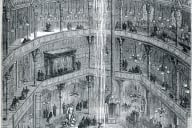You have /5 articles left.
Sign up for a free account or log in.
Many people -- including not a few members of his own party -- are dreaming of the day when they can point at the Republican presidential candidate and say, in their best imitation of his voice, “You’re fired!” But be careful: Donald Trump has attempted to trademark his catchphrase and the thumb-and-forefinger movement that accompanied it across 14 seasons of The Apprentice.
The U.S. Patent and Trademark Office rejected his application, but the man is almost compulsively litigious, and you might get a cease-and-desist order anyway. Trump’s claim on the expression and gesture as part of his brand was among the first revelations from my recent immersion in the scholarly literature concerning The Apprentice.
Yes, “the scholarly literature concerning The Apprentice” does sound like the premise for a bit of political satire, no denying it. But this report is nothing of the kind. No parody is intended, or necessary. My inquiry began on the assumption that I would probably find a couple of academic papers on Trump’s reality-television incarnation. Any hope of dashing off a quick-and-easy squib for this column disappeared as my reading queue filled up with a dozen articles from scholarly journals, not counting such tangential but pertinent material as Laurie Ouellette’s “Branding the Right: The Affective Economy of Sarah Palin.”
The literature varies considerably in emphasis and quality, and there is now, arguably, quite enough of it. Here are a few points gleaned from my reading.
The Apprentice debuted on NBC in January 2004; the first academic paper on it, Katherine N. Kinnick and Sabrena R. Parton's “Workplace Communication: What The Apprentice Teaches About Communication Skills,” appeared in the December 2005 issue of Business Communication Quarterly. The show’s basic template seems to have been preserved from season to season, as well as in the franchised productions in other countries:
Sixteen young professionals with impressive credentials and uncommon good looks compete in team challenges for a chance to earn a US $250,000 salary and the title of president of one of business mogul Donald Trump’s enterprises. At the conclusion of each episode, the losing team is called to Trump’s boardroom, where one player is eliminated with Trump’s now trademarked phrase, “You’re fired!”
The program rapidly established itself as the “highest-rated new show among the advertiser-coveted 18- to 49-year-old age group” in the United States, with the season finale drawing more than 40 million viewers. Subsequent papers on the British and Irish versions of The Apprentice demonstrate that the appeal was not strictly American. But the export failed in other markets. “Work, Power and Performance: Analyzing the 'Reality' Game of The Apprentice,” by Jo Littler and Nick Couldry (published in the journal Cultural Sociology in 2011), points out that the German and Finnish programs each lasted just one season.
At least some of the success of the British and American versions could derive from how the show translates the normally precarious conditions of employment under neoliberalism into the entertainment of a high-stakes game: “The fact that there are no safety nets for contestants on the program is constantly emphasized,” Littler and Couldry write. “Indeed, the risk of being cast aside is turned into a source of dramatic excitement and tension (‘You’re fired!’).” Viewers accustomed to social-democratic norms of employment might be less inclined to feeling vicariously involved in the contestants’ hopes and fears. The authors note that on the short-lived Finnish show, “You’re fired!” was replaced with “You are free to leave” -- a less humiliating pronouncement, if somewhat anticlimactic by contrast.
In their pioneering discussion of “what The Apprentice teaches about communication skills” from 2005, Kinnick and Parton cited a letter to The Wall Street Journal in which “Trump claimed that many business schools have made The Apprentice mandatory viewing and that he has received many letters asking that the episodes be packaged for the educational market.”
Of late, the words “Trump claimed” inspire far more caution than they once did. Still, much of the scholarship on The Apprentice takes its pedagogical significance as a given. Whether or not Trump’s name appears on the syllabus, his reality-television program is, after all these years, an element of how students entering the classroom understand or imagine the white-collar workplace.
In their content analysis of the first season, Kinnick and Parton identified a number of what they called “Trumpisms”: statements made on camera by the tycoon offering advice on communication and persuasion in the business world. (One example may suffice: “Negotiation is a very delicate art. Sometimes you have to be tough; sometimes you have to be sweet as pie -- it depends upon who you are dealing with.”) Kinnick and Parton wrote very little about Trump’s apothegms, and later scholars have found even less to say. The show’s more important lessons are taught, rather, by example.
Two papers by Chit Cheung Matthew Sung -- “Exploring the Interplay of Gender, Discourse and (Im)politeness” (2012) and “Media Representations of Gender and Leadership From a Discourse Perspective” (2013) -- point out how Trump’s interaction with the losing team in each week’s episode establishes the de facto norms for acceptable communication.
Because the main objective of the meeting is for Trump to find out which member in the losing team is the weakest and should be fired, stereotypically masculine, aggressive behaviors such as insulting, criticizing, attacking others to put them down are not only common, but also considered normative at times. Indeed, the classification of the boardroom interaction as taking place in a “masculine” domain can be justified by, for instance, Trump’s usual style of speaking during the boardroom meetings over the 15 episodes: the frequent use of interruptions, the issuing of direct and unattenuated directives, the giving of cruel criticisms and negative evaluations without mitigation, and his dominance of the speaking floor.
The zero-sum approach leaves precious little room for communication styles that “place emphasis on the relational aspects of the interaction” while fostering “avoidance of confrontations,” “the use of politeness strategies and hedging devices, as well as minimal responses and supportive feedback.” Such interaction is typically identified as feminine. The association between gender and interaction style here is open to question, of course, but in the world of The Apprentice, it usually operates to women’s disadvantage in fairly direct ways: “While being tough may run the risk of being negatively perceived as ‘unwomanly,’” writes Sung, “acting in a feminine way may be seen as a sign of incompetence and viewed more negatively than being ‘rude.’”
A double bind, then, in effect, but with consequences going beyond any supposed “war of the sexes.” Writing in the Western Journal of Communication (2011), Daniel J. Lair finds another layer of mixed messages -- seeming to endorse old-fashioned diligence and virtue while simultaneously making considerable allowances for manipulative behavior and unbridled self-promotion. In “Surviving the Corporate Jungle: The Apprentice as Equipment for Living in the Contemporary Work World,” Lair writes:
On its surface, The Apprentice suggests that the key to success in the contingent new economy has not fundamentally changed, and that a “by your bootstrap” mentality is every bit the foundation for the reality television contestants of 21st-century late capitalism as it was for the characters of Horatio Alger’s early capitalism novels of the 19th century. Beneath that surface, however, savvy viewers uncover a strategy suggesting hard work, talent and perseverance are not enough, and that to really succeed one must adopt the cynical, detached attitudes governing the “game” of aestheticized work.
In “the ‘game’ of aestheticized work,” every decision and gesture is driven by the need to promote the self as brand. That, at least, is one business Trump has run without bankruptcy -- of the financial variety, anyway. And it’s one he can always go back to, whatever the electorate may decide.




